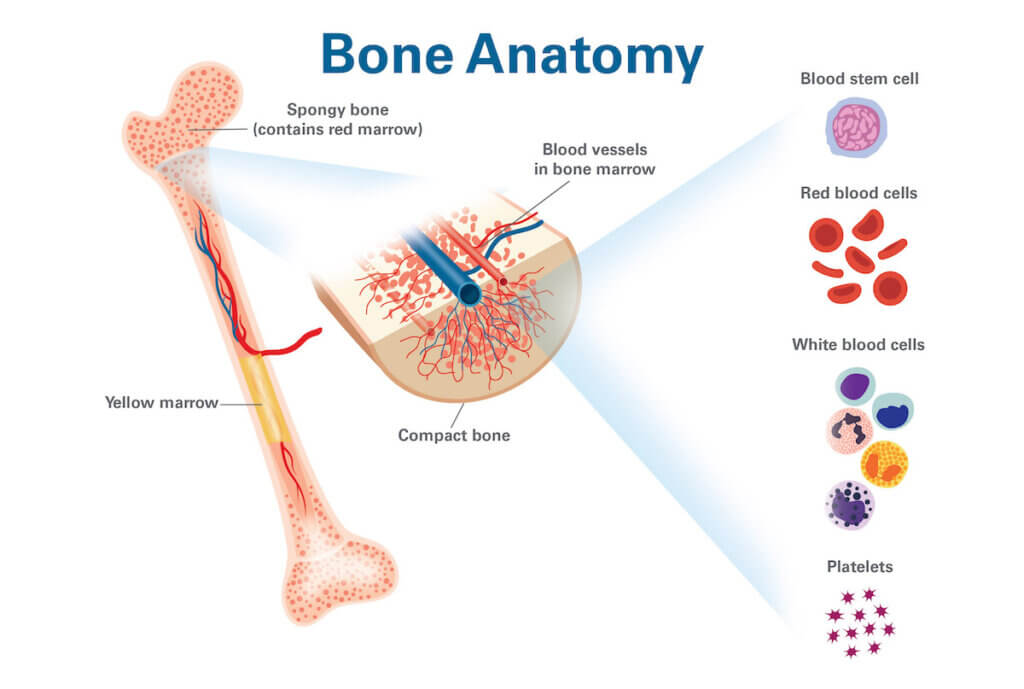Bone marrow is the soft, spongy material inside our bones. Occupying one of the most protected places in the body, it produces nearly all the components of blood. These include red blood cells, which deliver oxygen throughout the body, white blood cells, which help fight disease, and platelets needed for clotting. The marrow generates approximately 500 billion new blood cells every day.
What is bone marrow made of?
There are two types of marrow, named for their color.
- Red marrow consists of blood-forming stem cells, also known as hematopoietic stem cells. These can become red or white blood cells or platelets.
- Yellow marrow consists mostly of fat but also contains stem cells that can become cartilage, fat, or bone cells.
The marrow also includes stromal cells, which can form the connective tissue of any organ in the body.

How much bone marrow is in the body?
The average adult has just under 6 pounds of bone marrow, evenly divided between red and yellow marrow.
Which bones have the most marrow?
In adults, bone marrow is primarily located in the long bones of the upper arm and legs, ribs, vertebrae of the backbone, sternum (breastbone), and the bones of the pelvis.
What diseases originate in the marrow?
Like all tissues and organs in the body, bone marrow can become diseased. Because of the marrow’s critical role in generating blood cells, these diseases can have far-reaching consequences. An individual whose marrow doesn’t produce enough white blood cells, for example, can be subject to a wide range of infections and other diseases. An individual with an insufficient supply of red blood cells can experience extreme fatigue, tiredness, and other symptoms. Someone whose marrow cannot produce platelets is likely to have excessive bleeding or bruising.
Diseases originating in the bone marrow include:
- Leukemia, a cancer that develops in blood-forming stem cells, causing the production of abnormal white blood cells. It can be acute or chronic.
- Myelodysplastic syndromes, in which the bone marrow does not make functional, healthy cells, which leads to low levels of blood cells.
- Aplastic anemia, in which there aren’t enough cells in the bone marrow to fully supply the blood
- Myeloproliferative neoplasms, in which the bone marrow makes too many red blood cells, white blood cells, or platelets
- Multiple myeloma, a cancer in which abnormal plasma cells — the producers of antibodies — build up in the bone marrow
- Iron deficiency anemias, which lead to the formation of small, deformed red blood cells
- Thrombotic thrombocytopenic purpura, which results in reduced platelet production
Other cancers can spread to or invade the bone marrow, leading to abnormalities in blood counts.
How are bone marrow diseases diagnosed?
A diagnosis requires a bone marrow biopsy, in which a sample of marrow is removed for examination. In the procedure, a clinician uses a local anesthetic to numb the area at the back of the hip bone. The clinician then inserts a needle into the bone to extract a small amount of fluid and a small “core” piece of bone that is generally 1 cm by 0.8 cm. These cells are then examined under a microscope and evaluated for other markers to diagnose the disease. Other diagnostic tests include cytogenetic analysis and molecular profiling to look for certain genetic abnormalities of the bone marrow cells.
How are bone marrow diseases treated?
Treatment is always geared to the specific disease a patient has, as well as factors such as the patient’s age, overall health, the aggressiveness and specific features of the disease, and its response to previous therapies. Traditionally, treatment has involved chemotherapy, although novel, targeted agents are being developed based on new knowledge of genetic mutations found in some diseases of the bone marrow.
Some patients are eligible for a stem cell transplant, which involves treatment with chemotherapy followed by a transplant of hematopoietic stem cells to replace diseased bone marrow with healthy marrow.
The stem cells used in a transplant are usually harvested from the bloodstream but in some cases are collected from the marrow in a procedure similar to a bone marrow biopsy.
How can I keep my bone marrow healthy?
A healthy marrow can have a big impact on the body’s overall health. These steps can help keep your marrow healthy:
- Eating a balanced diet with sufficient vitamin B12 and folate
- Abstaining from smoking, which is a known risk factor for multiple marrow malignancies
- Limiting alcohol intake, which has been known to suppress bone marrow production
About the Medical Reviewer

Dr. Winer received his MD from The University of North Carolina School of Medicine in 1999. He completed his residency in Internal Medicine at Tufts Medical Center. He remained at Tufts Medical Center for a clinical hematology/oncology fellowship, which he completed in 2005.
